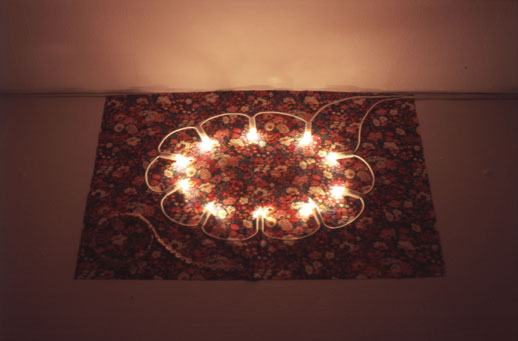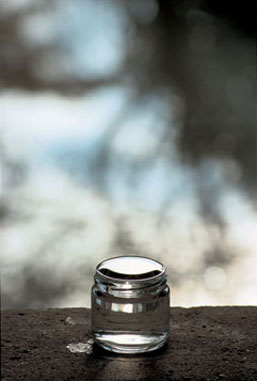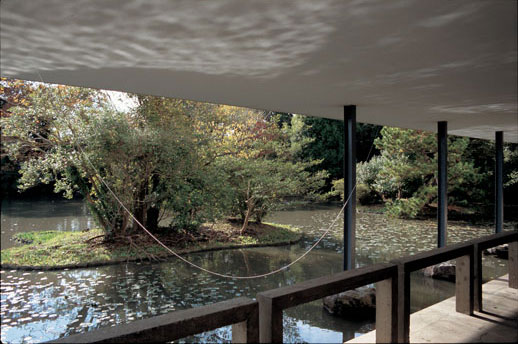Nature giving birth to nature
At first Rei Naito’s work appears to be more about what is not there than what is. Water, air and light compose her current show in Kamakura. On closer inspection the infinitesimal details of her materials become more and more noticeable. She approaches art from a literary vantage point, writing poetry in the sky with delicate ribbons and hanging clear beads in precise stanzas. I sat down with her on a crisp winter day to talk about her current show at the Museum of Modern Art, Kamakura.
I understand you made a number of visits to the museum to plan the exhibit. What were your first impressions of the space?
I was struck by the glass cases in the first gallery. Most artists probably think of those spaces as hard to use but I considered what the space means to me personally as well as what the cases were originally used for. Not a hindrance but a possibility. I didn’t want to conceal things. I was also struck by the openness of the museum space. It’s hard to tell exactly where the indoor ends and the outdoor starts. Wind blows freely through the space. Altogether it’s an idiosyncratic place. The next time I went I asked, “Is it ok to go inside the cases?” They said, “Yes.” And I thought is it ok to have viewers go inside?” They said “Ok.” At that point my ideas came for the exhibit. I wanted to put living people on display in the cases. I wanted to make a space where people would walk around, circling here and there, noticing and being noticed at the same time.
Your projects in Venice and Naoshima require viewers to see the work one at a time. How did you consider the ways viewers would encounter your installation this time?
There is no limit to the number of people that can be in the gallery this time. Recently I am thinking more about how people notice themselves in relation to other living beings while inside of a larger landscape. People inside the glass case notice other viewers in the gallery while viewers in the gallery also notice people in the case. While walking reflections come and go in the glass.
What does the title for this show “Tout animal est dans le monde comme de l’eau a l’intérior de l’eau” refer to?
I became interested in George Bataille’s writings many years ago. The title comes from his work. Animals are composed of water. The world is interconnected and becomes one. Humans think they are different because they know poetry and have consciousness. Nevertheless I think people are connected to the rest of the world, so I have this desire to capture, surrender, and discover this connection.

Who have you been reading lately?
I have been reading Rainer Maria Rilke for a long time. Also Simon Weil. Those two are quite important for my growth and I feel a deep influence from them.
![Photo: Naoya Hatakeyama Rei Naito, 'the spirit' (2009 [2006-])](http://www.tokyoartbeat.com/tablog/entries.en/wp-content/uploads/2009/12/rei-naito-kamakura-2.jpg)
That’s a hard question. One thing I can say is that the contents of people’s hearts are complicated. When looking at an artwork each person’s circumstances shapes their way of seeing. The works are subtle so I don’t expect people to understand my reasons for making things all the time. I just don’t think that way. Since we are becoming the same humans I want to express this sentiment at times. What the artist becomes aware of is just one part of the work. It can’t all be understood. I don’t want to make things that I completely understand. There are lots of things I don’t understand but I can gently assert, “This is just what it is.”
How did you select the cloth used for the floor installation in the second gallery?
It’s like playing house as a child, making miniatures. I don’t make paintings. But I enjoy searching for cloth. Finding things that I like, its closer to the work of an anthropologist or sociologist. I always use normal cotton fabric. Often with flowers and plants. If you think about it, why people started using these patterns, its mysterious, isn’t it? I choose patterns with small flowers and plants and create scenery similar to a child’s play.
And how did you decide on the arrangement?
I was thinking about the birth of the universe before humans, in a state of chaos, the birth of our earth and the potential of what was to come. It’s a new field, I don’t know if it was like an ocean, a forest, or something else but I wanted to make the field that underlies everything. It’s completely random but as the cloth gets closer to the viewer it takes on patterns, something like waves.

At first I thought the space would transform into this kind of space with cloth. Next I thought about writing “Oide” on each sheet of paper. That refers to being born into the world, the beginning of our life, come here come here. Nature is saying, “come, come.” It’s not me saying it. Nature is giving birth to nature. After being born its like “come, come” continue living in the world. The same patterns from the cloth accumulate into infinity. Then I put the paper there.
You included many glass jars with differing amounts of water. Why were the jars indoors less than full while the outdoor jars overflow with water?
Japanese people use water as an offering to ancestors and home shrines. For those who have died I put water in some jars as an offering and left other ones empty. It’s a requiem for dead spirits by the living. I think it’s important to offer a blessing to dead people and unborn spirits. Nature is really made of both life and death. People think we are living here but we are really just composed of cells that are regenerating from one moment to the next. We are made of the same water as others.
Can you tell me a bit more about the project you are doing on Teshima? How are you and the architect Ryue Nishizawa considering the space of the museum?
My work will be inside the building. I wouldn’t exactly call it an art museum. It’s shaped like a falling water drop. There are no cylinders and it’s a large concrete building, about 40 meters wide. My work will essentially be composed of water on the floor. We work together so he asks me what do you want to do and I ask him what do you want to do. While listening to each other we consider the wider surroundings on the island. It is scheduled to open in October 2010.

James Jack
James Jack



